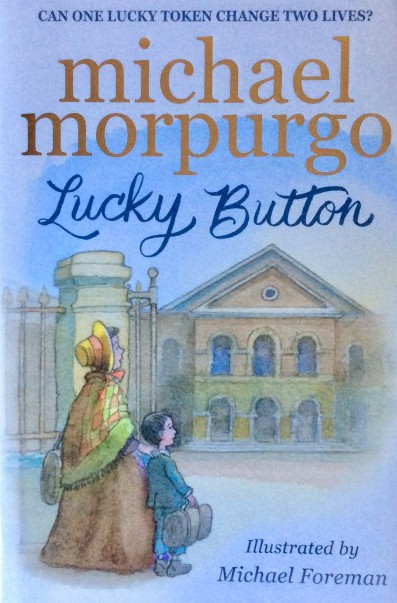Inspiring Young Readers
 posted on 05 Jan 2018
posted on 05 Jan 2018
Lucky Button by Michael Morpurgo, illustrated by Michael Foreman
I am always delighted to find another collaboration between one of the best modern storytellers, Michael Morpurgo and one of my favourite illustrators, Michael Foreman. It gives me the very comfortable experiences of being in ‘safe’ hands so that I can settle down to read and enjoy the treat in one sitting if possible.
This one cast its spell very quickly as we are first introduced to Jonah, a sensitive young lad who cares for his invalid mother who is often depressed. Their tender and intense relationship is very well described and it is to his credit that Morpurgo doesn’t shy away from depicting the difficulties of her ‘dark times’ and how Jonah has to help her through . They are fortunately bound together by a love of music and the beauty of nature and these are recurring themes throughout the story. Apart from being a young carer, Jonah has to cope with the trials of school, ‘a loud world of bustle, banter and babble’ which he struggles with. His name derives from the story of Jonah and the Whale in the Bible and adds to his discomfort as his consequent school nickname is ‘Moby Dick’. He is taunted with choruses of ‘ blubber, blubber’ from many classmates along with some physical bullying so life is not very pleasant, but he mustn’t let his mum know.

Apart from his interest in music, he is also fascinated by the magnificent school buildings which are set in a Hertfordshire country house that was once a Foundling Hospital. He prefers his own company and so often finds refuge in the school chapel where he likes to sit alone quietly singing and imagining the past and it is there that one day he finds a curious old button on the floor. He is then startled by a phantom organist who offers him friendship:
‘You and I, we have more in common than you could possibly imagine. Our lives may be hundreds of years apart, but they meet here today, and all because of this lucky button’.

It turns out that the phantom was one of the foundling children who lived in the London hospital, long before it was moved to its present location in the countryside in 1935, and he was ‘much weighed down by sorrow and care’ . He tells Jonah all about the generosity of the founder philanthropist Thomas Coram and how he changed the lives of poor children who may otherwise have starved. He explains that, like all the founding children, he was given a new name and then fostered out to a loving family in the countryside where he spent an idyllic early childhood described evocatively as:
‘full of delights: butterflies and flowers in the garden; digging potatoes; Mrs Ma’s wondrously delicious tattie pie; riding home from harvest fields with Mr Pa on Friend, the big farm horse; paddling in the sea and swimming in the dyke.’

The phantom’s name is Nathanial Hogarth and he tells Jonah the fascinating story of his own often unhappy childhood when he is forced to leave his foster family and return to the Founding Hospital. Like Jonah, his saving grace is also a love of music and he is particularly impressed by George Frideric Handel who performed the Messiah with an orchestra and choir every Christmas in the chapel. Nathanial eventually becomes an apprentice to the carriage driver of William Hogarth, the painter (who is incidentally a big hero of the illustrator Michael Foreman). They share the same surname because, as a benefactor to the Foundling Hospital, he gave his name to several infant foundlings and had been following Nathanial’s progress with interest. His many exciting adventures continue so that his life also becomes entwined with the composer John Sullivan and even the precocious young Wolfgang Mozart and his family.

There is so much history cleverly stuffed into this book apart from the engaging life story of Nathanial and how he came to find personal happiness. In this way, the author is able to inject plenty of interesting cultural history as well as information about how foundling children were cared for in the past and why such institutions were needed. Jacqueline Wilson has done something similar with her Hetty Feather series of books and I do hope that children are being encouraged to read these fictional accounts in school and are so encouraged to find out more about the subject.

This book is all about sharing the good and not so good moments in life and Nathanial’s memories allows Jonah to reflect on his own life so far and how it might change for the better, which it does. I strongly recommend this optimistic and engagingly told story about friendship and hope where the many wonderful illustrations painted in Foreman’s distinctive palate add to the generous and warm atmosphere.
Karen Agent
January 2017